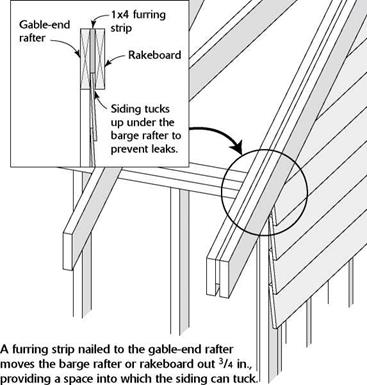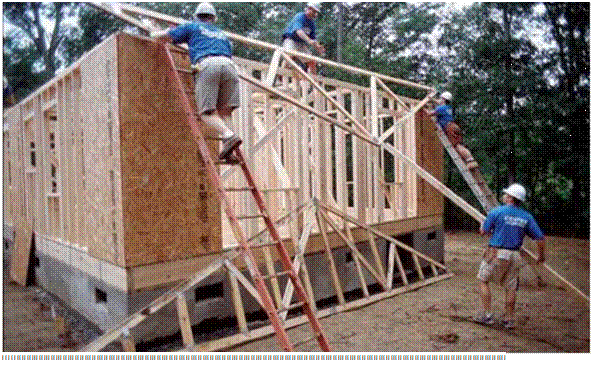WORK SAFELY ON A ROOF
Keep your wits about you and pay extra attention to what you’re doing when you’re up on a roof—both to keep yourself safe and to ensure that the integrity of the roof is not compromised. To get on and off the roof, use a good, sturdy ladder that extends 3 ft. above the edge of the roof.
■ Keep the roof clean so that there won’t be anything to trip over.
■ Be careful when sawdust is on the roof. Sawdust on a sloped roof can be as slick as ice. To be safe, call out measurements to cutters on the ground and have them clear the board of sawdust before handing it up to you.
■ Never throw anything off a roof, not even a shingle, without first checking to see that no one is down below.
■ In the hot sun, asphalt shingles soften and tear.
Walk gently so you don’t damage the shingles. In hot weather, install shingles early in the morning or late in the afternoon.
■ In bitter cold weather, shingles become brittle and crack. Work carefully, and pray for sunshine.
■ Shinglers who nail off a roof by hand often sit on the roof as they work. In hot weather, try sitting on a piece of foam while nailing shingles. Otherwise, hot shingles can literally burn your backside.

 Unless the trusses were set on the walls at the time of delivery, they must be hoisted onto the walls by hand (see the photo on the facing page). One way to do this is to set good, strong ladders at both corners of the building. If you’re dealing with long trusses, place a 2x in the center, from the ground to the top plate, at the same angle as the ladders. This way, two people can lift a truss, lay it against the ladders and the center 2x, and walk it up to the top. Another person in the middle with a notched pole can push on the truss as needed.
Unless the trusses were set on the walls at the time of delivery, they must be hoisted onto the walls by hand (see the photo on the facing page). One way to do this is to set good, strong ladders at both corners of the building. If you’re dealing with long trusses, place a 2x in the center, from the ground to the top plate, at the same angle as the ladders. This way, two people can lift a truss, lay it against the ladders and the center 2x, and walk it up to the top. Another person in the middle with a notched pole can push on the truss as needed.
In preparation for installing the first truss (the gable-end truss), I nail a long, straight, temporary 2x brace on edge to the wall frame near the center of the end wall. This holds the gable – end truss stable until other braces are installed.
If the truss is not too large, one person on top can drag the truss to the opposite end and lift it up against the temporary brace. Make sure that the eave overhangs are correct and that the outside of the bottom chord is flush with the outside of the end wall’s top plate. Toenail the bottom chord to the double top plate, driving 16d nails every 16 in.

![]()

 |
Trusses take teamwork. A crew of four does a good job of getting roof trusses up on the walls. Using a long push stick, the ground worker helps elevate the truss.






Leave a reply